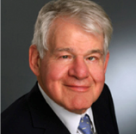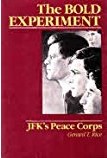Making Lemonade In The Maiatico Building, Part 4
The Peace Corps actually ‘started’ the day after Kennedy inauguration. Kennedy telephoned Shriver and asked him to form a presidential Task Force “to report how the Peace Corps could be organized and then to organize it.”
Shriver telephoned Harris Wofford and they rented two rooms for offices in the Mayflower Hotel, downtown in Washington, D.C. They were the “Task Force.”
They began to call people they thought might know something about international development and living in the developing world. One name led to another. Shriver says that he had no long-term, premeditated vision of what the Peace Corps might be. “My style was to get bright, informative, creative people and then pick their brains.”
The first official meeting of the Task Force was scheduled for February 6. Kennedy had requested a report from Shriver by the end of February. Shriver would later say, “I needed help badly.” On Sunday night, February 5, Shriver got a copy of The Towering Task.
Shriver created the Peace Corps in twenty-one days (from February 7, 1961–the day after he got The Towering Task– to March 1, 1961, when the Executive Order was signed by President Kennedy.) According to Wiggins, “That’s a record for a government agency. Something like a year or two is usually the case. But he got it together that fast; he created its laws, its principles, and he staffed it up.”
“Staffing up” meant appropriating three rooms on the sixth floor of 806 Connecticut Avenue, the Maiatico Building, [the first Peace Corps Office, now replaced by a slick building housing law firms] where Wiggins and Josephson already worked at ICA. Both of them soon would be working full time for the Peace Corps, Wiggins doing planning, and Josephson figuring out how to make the agency become a government agency. Josephson found the way in a little used President’s Executive Order.
Josephson researched the possibility of the Executive Order that the President could use at times of national emergency. Now, there was no emergency in the real sense of the word, but Josephson thought there was ‘reason enough’ to use the Executive Order to get the Peace Corps launched immediately. Josephson saw “ample authority for the President to provide immediate “contingent’ funding for the Peace Corps.” He found it Section 400 of the Mutual Security Act of 1954. [Josephson also found precedent in FDR’s establishment of the Emergency Conservation Corps in 1933.]
Josephson proposed that the president take advantage of his rightful powers and bring the Peace Corps into existence, temporarily bypassing the need for congressional approval. This combination of “big” and “fast” and “bold” appealed to Shriver and Wofford and others in the ‘Mayflower Hotel Gang” who had been involved in the writing of the Report for JFK.
The White House wasn’t buying. Ted Sorensen told Shriver that the Report was different from what he had envisaged. Kennedy’s staff had wanted something small, “a low-cost addendum to the overall foreign assistance program” and Shriver had come up with a large, independent new government agency which could be in the field within a few months.
Coates Redmon in her book on the early days of the Peace Corps, Come As You Are, makes another point about why the Peace Corps had to be established quickly, and this was Shriver’s argument that it was “now-or-never” for the class of 1961. They would be graduating in three months, and they were, in his thinking, the crucial Peace Corps Class. Also, by moving quickly, before summer, it would give them the opportunity to do training on empty college campuses across the U.S.
In his book, The Bold Experiment: JFK’s Peace Corps, Gerard T. Rice points out Josephson also argued that if “the Peace Corps waited the six months it would take to get a bill through Congress, it would miss the potential recruits from the colleges and university in the summer of 1961 and would possibly not be in operation before the winter of 1962. A presidential Executive Order was the only viable means of giving the Peace Corps the head start it needed.”
Key help came from Larry O’Brien, special assistant to the President for congressional relations, who recalled being “extremely impressed” by the Peace Corps young advocates. He agreed that the Executive Order would be an effective tactic. As Rice points out in his book, O’Brien’s agreement was important because Kennedy himself “was not overeager to expand his presidential prerogative unless absolutely necessary” and Congressmen would not take kindly to an early invasion of their legislative rights.
But on March 1, a week after he had received Shriver’s Report–and only three weeks after the first Task Force meeting–Kennedy signed Executive Order 10924. The Peace Corps became the only program of the Kennedy administration allowed the distinctive status of an ’emergency agency.’
Until March 1, 1961, Josephson was the only lawyer in the new organization and 1) he had the idea of an Executive Order, 2) he was the principal author of that order which brought the Peace Corps into existence.
While the Peace Corps has had over 200,000 PCVs, staff, etc. since then, what is interesting to note and remember is that individuals made all the difference at critical moments in its creation. [Murray Frank, for example, holding the Volunteers together in Nigeria after the postcard incident.] Wiggins with The Towering Task; Josephson coming up with the Executive Order. You can say, as many have, ‘these kids didn’t know any better and that is why it happened.”
Well, ain’t that the truth, and ain’t that great.


Yes, I quite agree with the authors you quote in Part 4 of the Maiatico Building “office”
I was Sarge’s last appointment as a Country Director in late 1965 before LBJ “moved” him from Peace Corps to VISTA.
George Carter, then Regional Director NANESA insisted that I be sworn in before March 25th 1966 when Jack Vaughn, Sarge’s successor was going to New Delhi with Carter for a all-NANESA Country Directors meeting. As informal as the meeting was ( including LBJ’s telephoning Vaughn that he had just promised Indira Gandhi 800 more PCV’s, not 10 minutes after Vaughn had promised the Reps that they would NOT be getting more volunteers than they said they could use) it was a no holds barred information session for me. From my job as one of three economists working for AT&T Corporate, this was a massive learning session. It was followed by my own desire to spend a week in Kabul, meeting 100 PCV’s in the capital, and getting briefed by the Acting Director, Bob McCluskey who was standing in for Bob Steiner who had been dispatched to Tehran to fill in after the incumbent Rep’ s mental health suffered a collapse.
Then came “training” in the Maiatico Building, a concatenation of Mickey Mouse cases, pedantic lectures about PC policies, very little about support by PC/W for the far off “colonies” and a strong impression that the only way to find stuff out was by using every possible personal contact at headquarters. I knew the Deputy Director of the Psychiatry office socially, and of course my Desk Officer, Bob Pearson, who had been one of the original PCV’s. Bob was willing to exchange reel tapes of what was REALLY going on in Washington, and I in Kabul, a communication method by diplomatic pouch that would avoid wider scrutiny, but let me know what was what in PC/W
I told Pearson about my misgivings about sending home the most part of a 30+ contingent of RN nurses who insisted on quitting because, they were being chased around the OR by Afghan doctors, had no working autoclave, no alcohol, no sterile needles…I warned them that they would forfeit the end-of-tour-bones as well as having to pay their own way home, but they said they didn’t care–they just wouldn’t stay! So the next time I was at PC/W after going to a Selection Board in Texas of traine simply stated that they wanted to go home. I warned them that they would forfeit both the end of tour financial package and pay their way home So, once back in the Building, I spoke with a lawyer in Josephson’s office. I told him that I felt that PC was morally obliged to pay the nurses the funds they were due, but that I was legally prohibited from doing so. The lawyer asked me if I could read; I replied that Columbia Univ. did not hand out Master’s degrees to [ilegibles] . He said read this, IPD 3.1, I said I know it by heart and recited it back to him. “Ah, you quited it correctly : “under normal circumstances, P{CV’s who quit shal.l … All you need to do is to spell out these very extraordinary circumstances, and we’ll cable you to pay them!”
Had it not been for the TLC I got from Bob Steiner, Carter’s successor, VinceD’Andrea in Psych,Sol Chafjin in Planning and especially Bob pearson, I would have been a disaster.As it happened, I could have used a lot more guidance and responsiveness, but as you pointed out, that wasn’t the way PC/W was organized!
MY apologies for the typos: illegibles should have been “illiterate:
quited, should have been ” quoted”
Walter
Thank You, Walter. And, Thank You, John. Fun and entertaining to recall wise men doing great things…Compared to today, then was a time of legend making, dream catching.
WM
I loved reading the background of the “toughest job you’ll ever love!” And I do think the timing was essential… JFK ,with all his faults ,inspired us to “do for our country!”
What inspires kids today?????